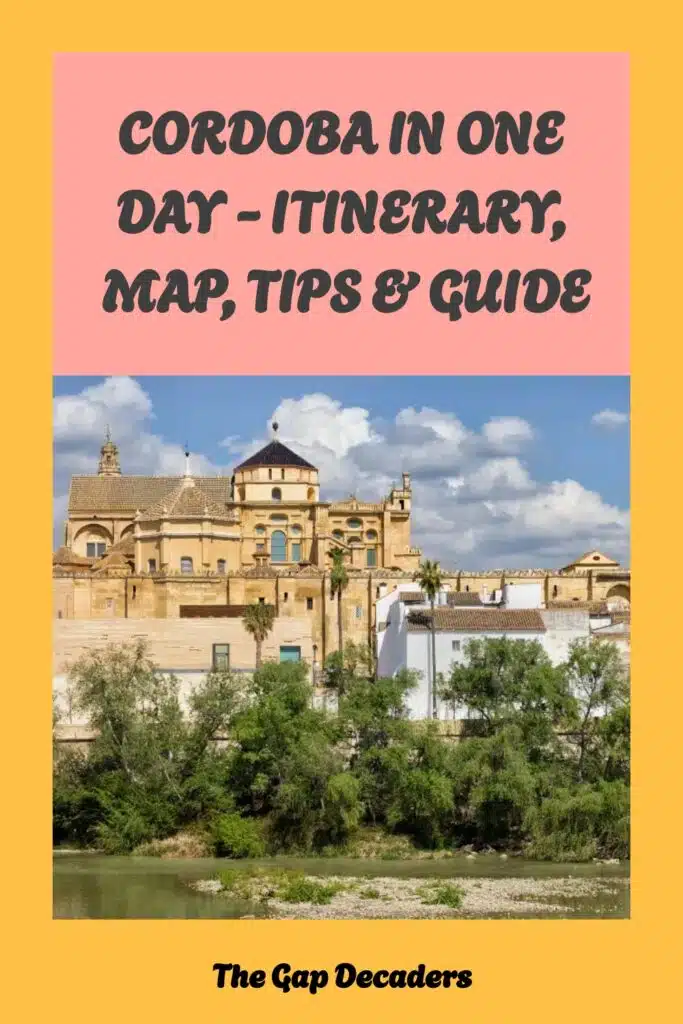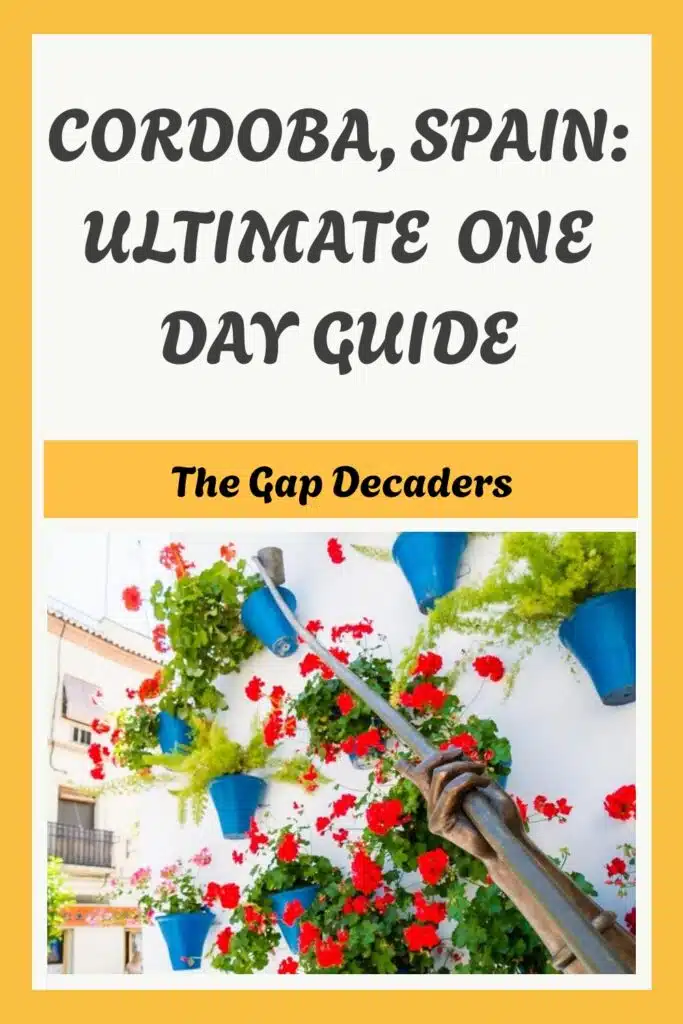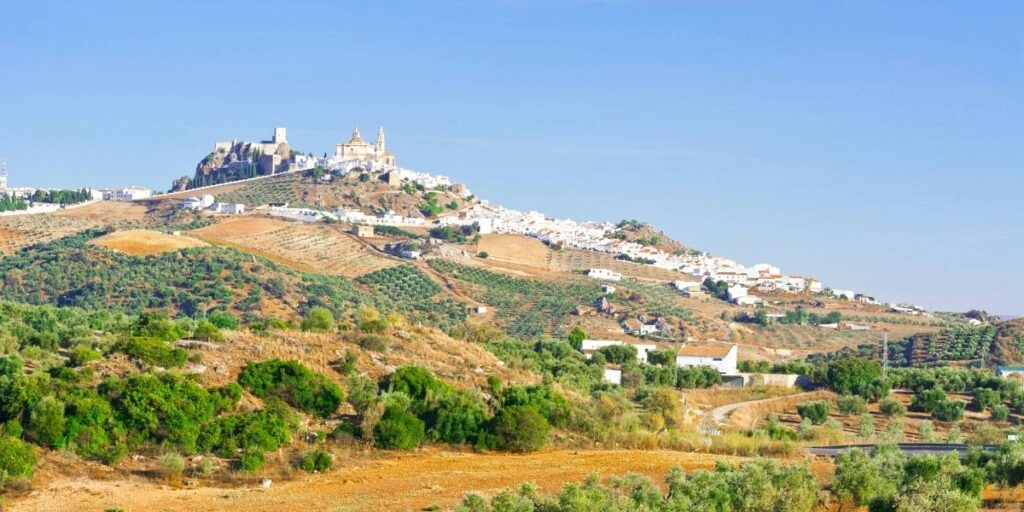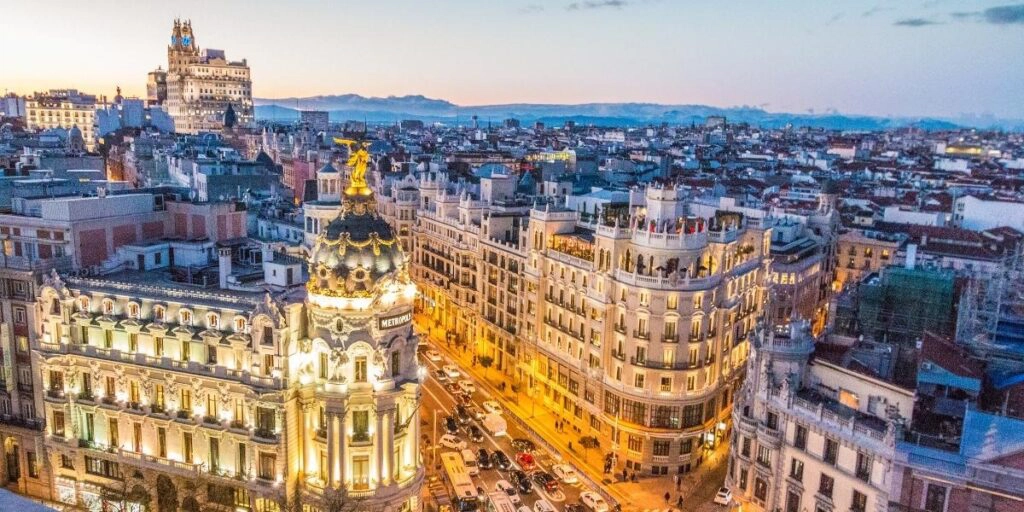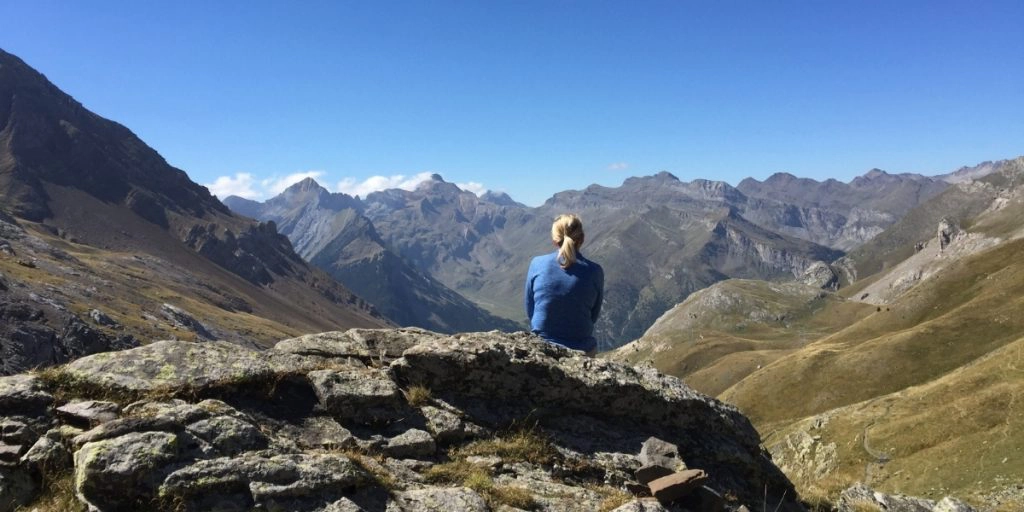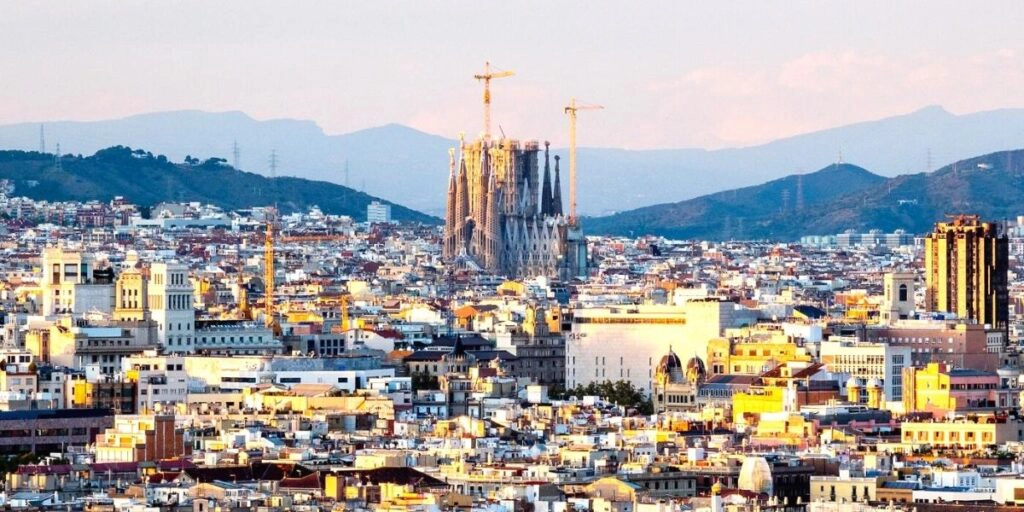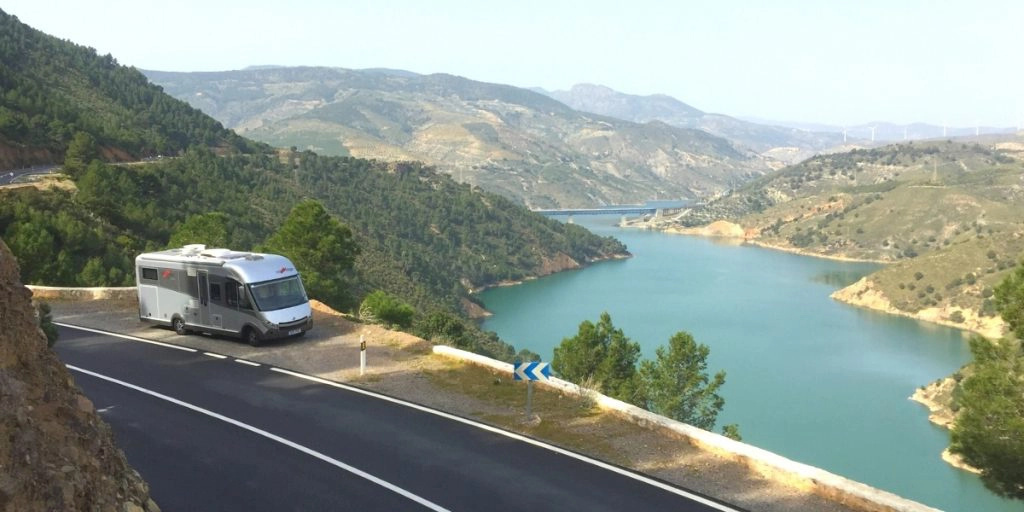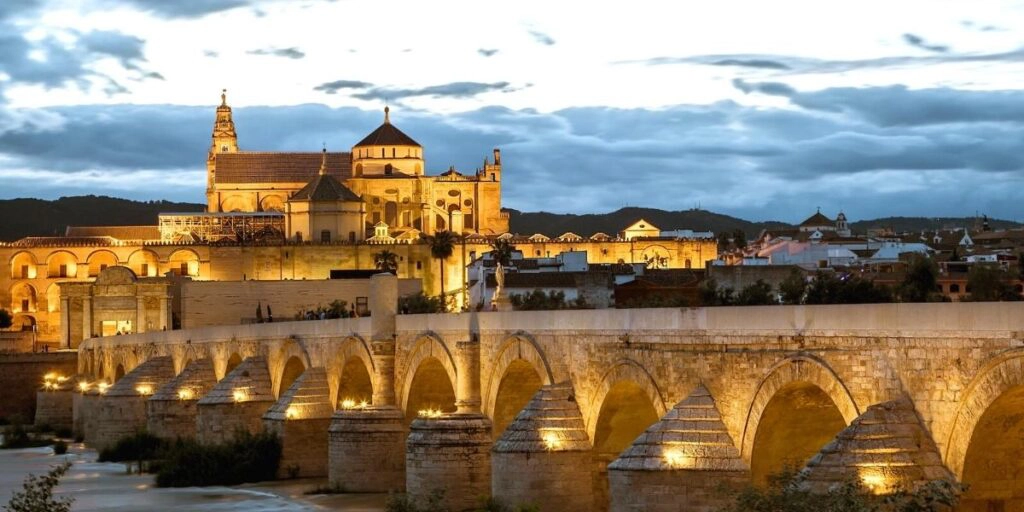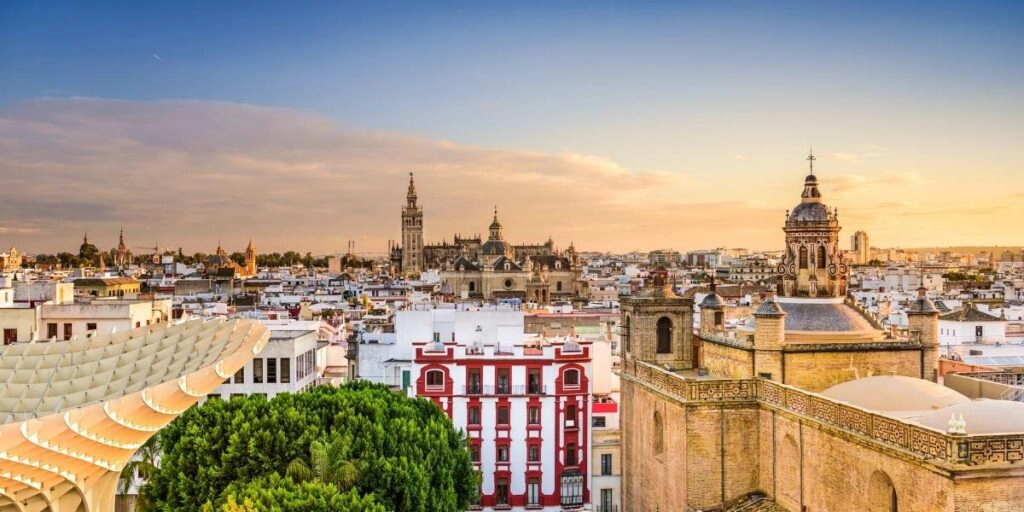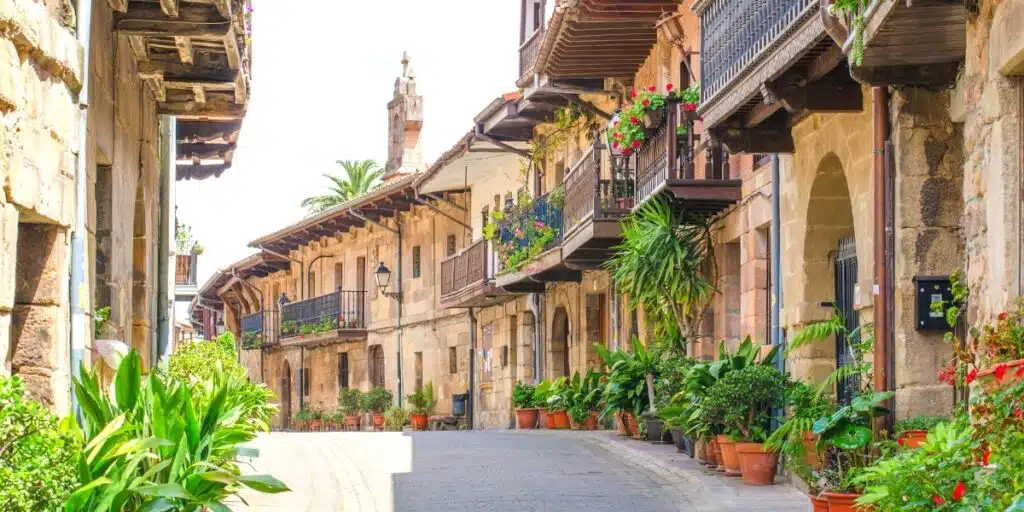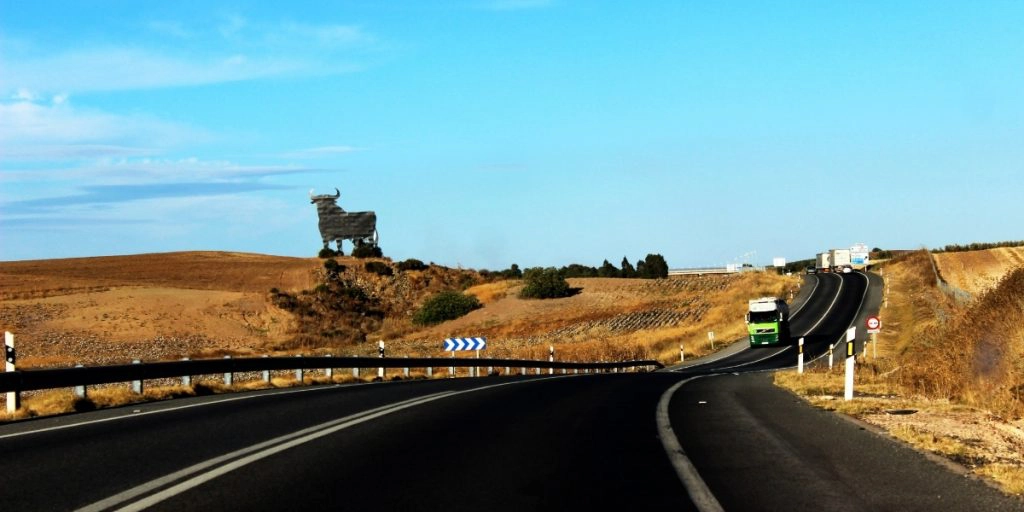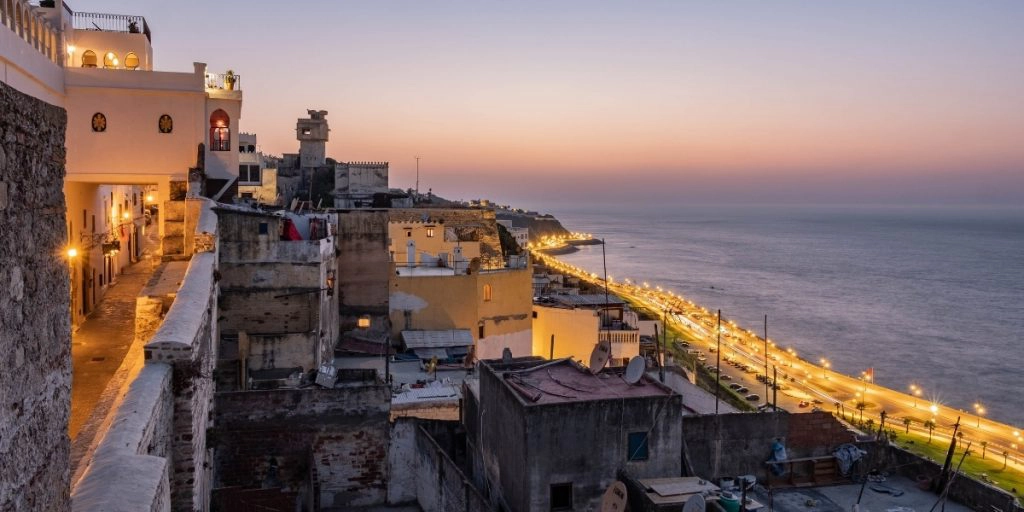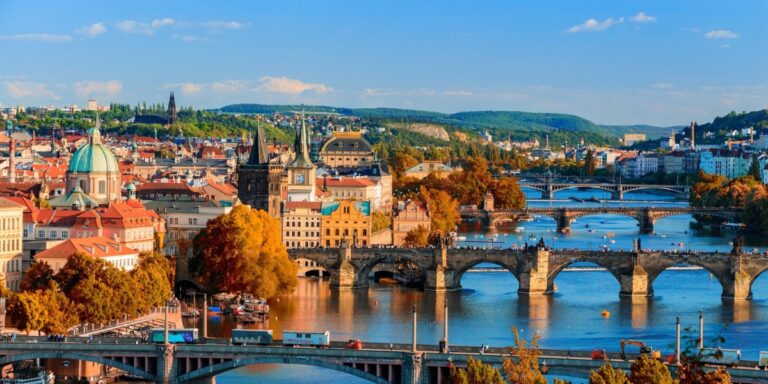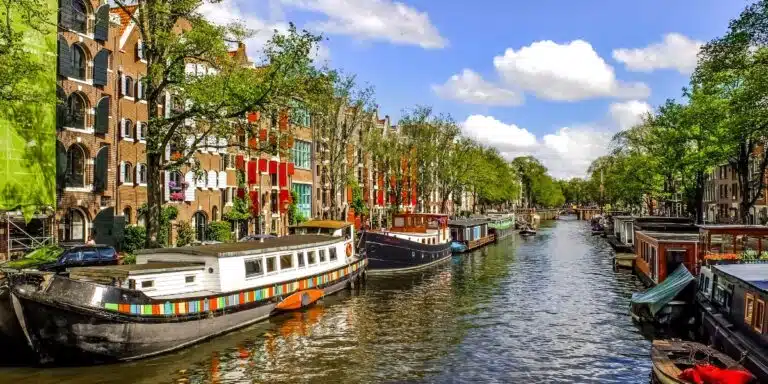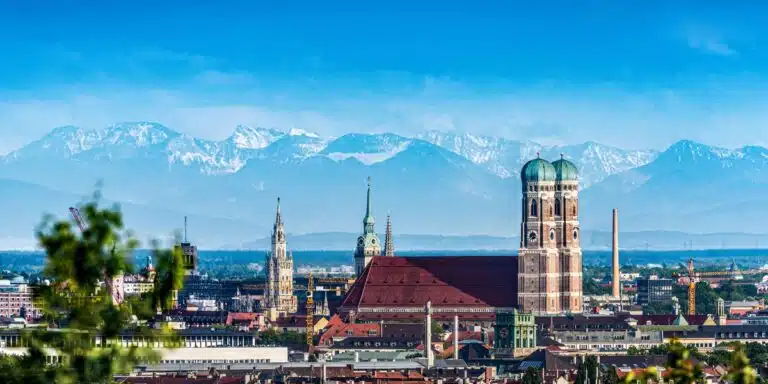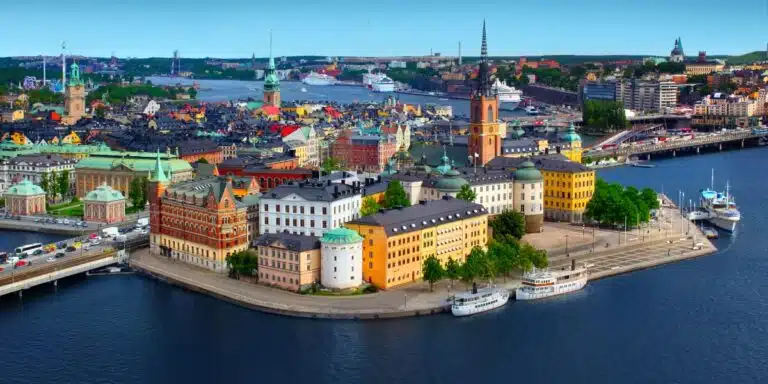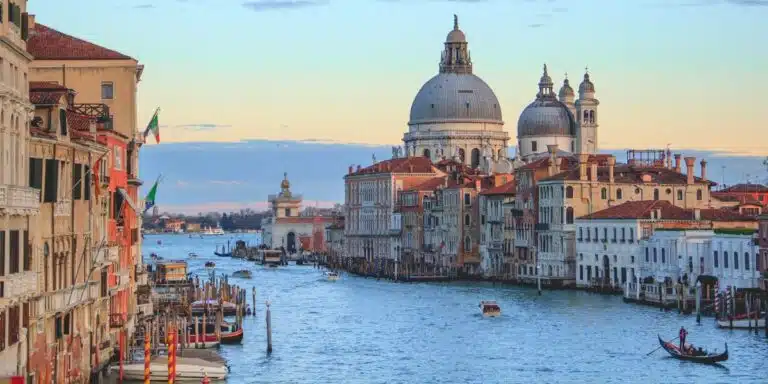This post may contain affiliate links, from which we earn an income.
How to Spend One Day in Cordoba Spain
Deep in the heart of Andalucia, Cordoba is known for its magnificent mosque-cathedral, winding streets full of flowers, and a vibrant ambiance. The beautiful city is a crossroads of European history and architecture, and full of Spanish charm, perfect for a one day visit.
Get lost wandering the streets and alleys of the historic city, soaking up the heat and atmosphere, whilst stumbling upon hidden corners, gorgeous squares, Moorish architecture, and cool bars.
In this Cordoba travel guide, you’ll find a complete itinerary of all the most important must-see Cordoba attractions, with an interactive map, organized to make the best use of your time. We also share recommendations for central places to stay, ideas about where to eat local food, and tips to help you unlock the essence of Cordoba in one perfect day.
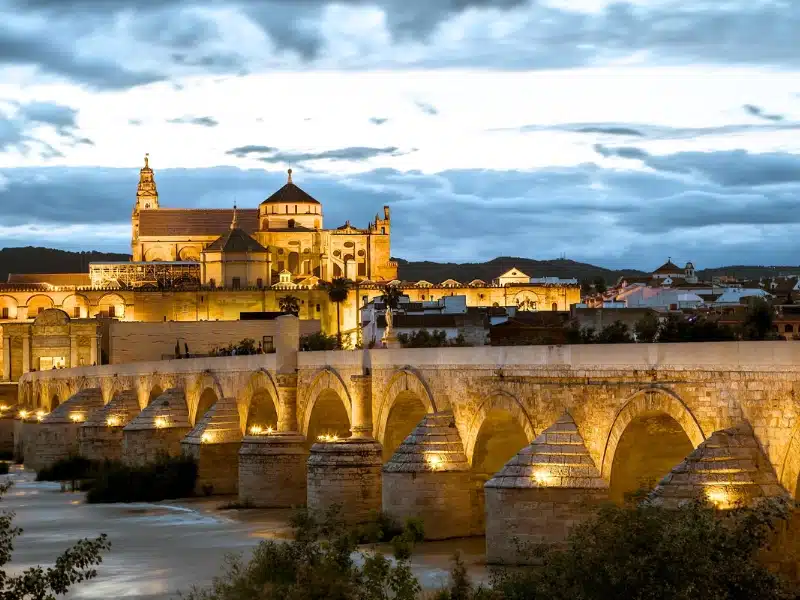
Are you planning your trip to Cordoba last minute?
Be sure to book your accommodation and tours in Cordoba ahead of time to ensure availability! Here are our top picks!
- Luxury: Balcón de Córdoba (superbly located, just gorgeous, our fave!))
- Mid-Range: Las Casas de la Juderia (central, charming and has a pool)
- Budget: La Boutique Puerta Osario (simple, clean and great value)
- Hostel: Líbere Córdoba Patio Santa Marta (well located at a budget price)
- To see the top four main attractions grab this guided walking tour
- To see everything, jump on the Cordoba hop-on hop-off bus tour
- Book skip-the-line tickets with a guided tour to see the stunning Mezquita
- Visit Cordoba’s iconic flower filled patios with a guided patio tour
- End your day with a sultry and traditional flamenco show with drinks
Make sure you have travel insurance you can trust when visiting Spain. We recommend True Traveller for their 5-star TrustPilot reviews, variety of cover options, best activities cover as standard, great prices, and excellent service.
Things to See & Do in Cordoba
Interactive Map
ROUTE: Mezquita – Alcázar de los Reyes Cristianos – Cordoba’s Patios – Templo Romano – Puente Romano – Calahorra Tower
How to use this map – Use your fingers (or computer mouse) to zoom in and out. Click or touch the icons to get more info about a place, and click the arrow in the box top left to open the index. To add to your own Google Maps account, click the star next to the title of the map.
Itinerary Notes
Morning
Unless you’re staying in the medieval old town, you’ll enter the old Roman walls through one of the remaining gates: Puerta de Almodóvar, Puerta del Puente, and Puerta de Sevilla. Built on top of the remains of Arab doors in the 14th century, these are the only three doors that are currently preserved in the historic center of Cordoba, a UNESCO World Heritage Site.
Be Awed by the Mezquita of Cordoba
The 8th century UNESCO World Heritage Site of the mosque-cathedral of Cordoba is the most awe-inspiring, breathtakingly beautiful building and one of Spain’s most famous landmarks.
Crossing the threshold of the great mosque through the main entrance of Puerta de las Palmas (Door of the Palms), the first sight is of 850 marble and onxy columns topped by jasper and granite red and white striped horseshoe arches. As the marble floor beneath them seemingly disappears into infinity, this is a real show-stopping moment.
Take a few minutes to appreciate the sheer scale of the building, the number of columns and arches, and the vast footprint stretching out in front of you before you start to explore.
Wander further into the Mezquita-Catedral de Cordoba to see the older and remarkably well-preserved, intricate, and symmetrical Islamic architecture of the original mosque built by Abd ar-Rahman I and dating from 786. Tiles, gold leaf, and beautifully carved wood provide rich color and texture.
In 1146, during the Spanish Reconquista, the conquering Spanish army entered Cordoba, and holy mass was celebrated in the mosque by the King of Spain. In the 13th century, the mosque officially became a cathedral, and many chapels, the choir, the transept, and the tower were added seamlessly to the existing building. The Gothic and Renaissance architecture displayed all the might and fervent religiosity of the Spanish monarchy.
The courtyard, which was used for purification rituals before Muslim prayer became a garden in 1597. Nowadays, the charming Patio de los Naranjos and its orange trees and palms provide shade from the hot Spanish sun to tourists and pilgrims.
Once you’ve explored the interior and spent a few moments on the patio, the perfect place for a shady rest, you should climb the bell tower, known as Torre del Alminar or the Tower of the Minaret, which stands guard over the building.
Climb to the top for panoramic views of the surrounding landscape and a great opportunity to study the roof of the building, which reminds you of the immensity of the undertaking. You need to book a slot for this at the Mezquita ticket office, and there is an extra cost, but we think it’s worth it.
If you do nothing else in Córdoba, visit the Mezquita. This highly-rated Cordoba Mosque-Cathedral skip-the-line guided tour will help you understand the fascinating history and architecture of this building. Make sure to book in advance for Cordoba’s #1 attraction.
TOP TIP: The mosque-cathedral is free to visit from Monday to Saturday between 8.30am and 9.30am. It’s a good idea to be there on the dot for the best chance of seeing the building without hordes of other tourists.
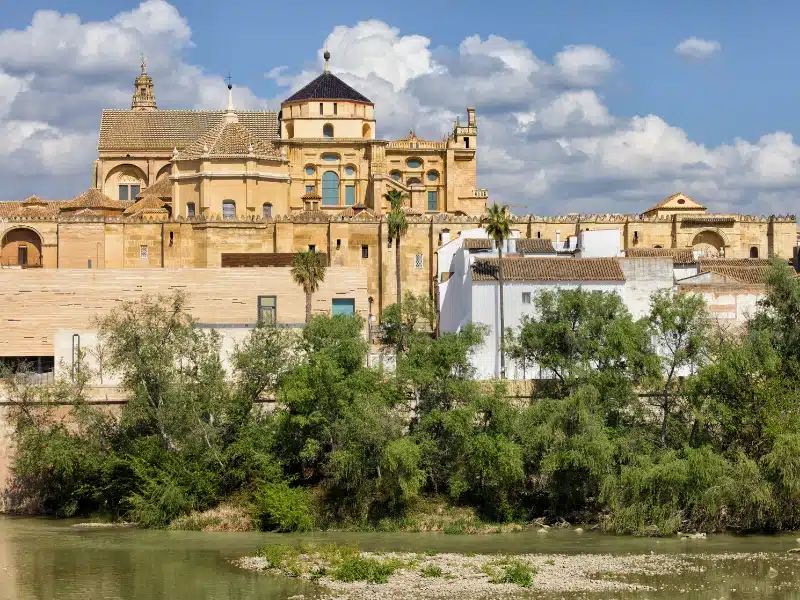
Visit the Alcázar de los Reyes Cristianos
Just a short walk from the Mezquita, the Alcazar of the Christian Monarchs, a historic royal residence, is another stunning building worthy of a visit, more for the beautiful gardens than the interior.
The Alcazar is a medieval citadel located in the historic center of Córdoba, on the river and very close to the Mezquita. The citadel served as one of the primary residences of Isabella I of Castile and Ferdinand II of Aragon, and they are known to have received Christopher Columbus there in the 15th century as he looked for a western sea route to Asia.
It is not possible to visit the whole interior of the Alcazar de los Reyes Cristianos in Córdoba, although what is open of the 15th century palace is well worth a look. The first permanent tribunals of the Spanish Inquisition were held here when they began using the Alcazar as a headquarters in the Middle Ages, converting much of it, including the Arab baths, into torture and interrogation chambers.
But that wasn’t the first time this place saw blood spilled in the name of religion. In front of the Alcazar and the 10th century Caliphal Baths, is the Plaza Campo Santo de los Mártires, also known as The Holy Martyrs Field. This is where, in 304 AD, the Romans executed Córdobans for proclaiming their Christian faith.
The royal palace gardens are magnificent, stretching over some 55,000 square meters across three levels and laid out with traditional Islamic symmetry. With elegant fountains and ponds, formal walks, and a large variety of species, this is a lovely place to while away an hour or so.
The gardens also host the Naturaleza Encendida: Raíces Show or Cordoba Light Show, an immersive experience that captures the essence of the gardens through impressive lighting and fascinating projections.
The Alcazar is a really lovely place to wander, but to fully appreciate the depth of history and richness of the architecture, crossing both Spanish and Moorish cultures, we recommend this Alcazar guided tour which includes a skip the line ticket.
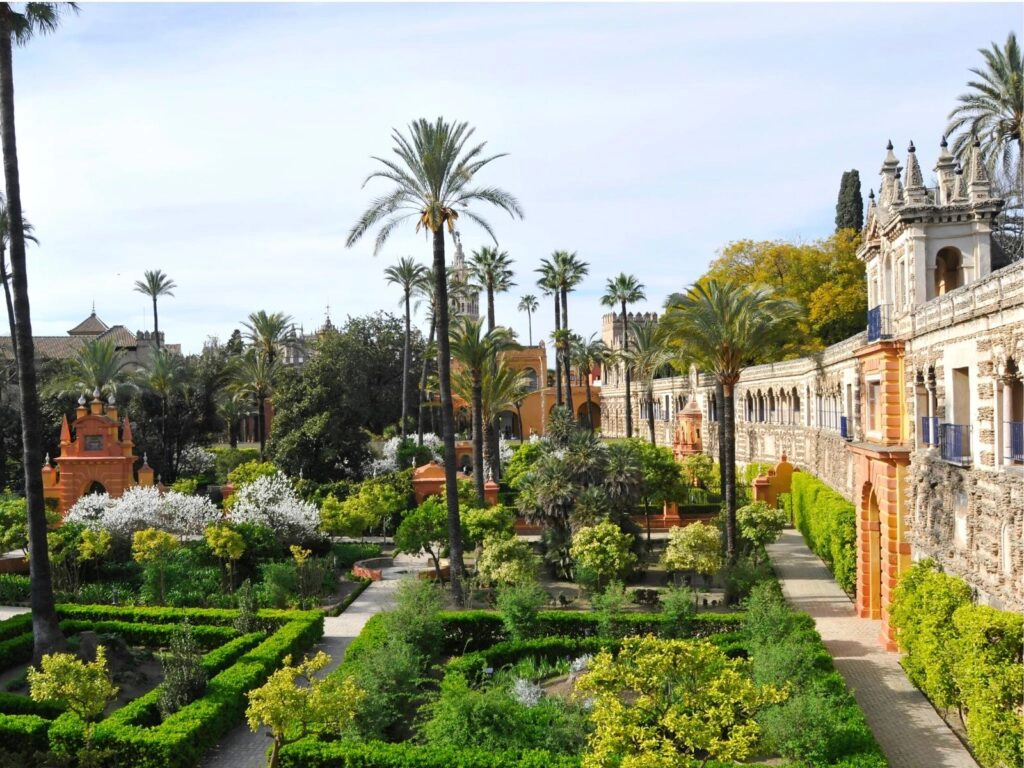
Spain Travel Inspiration
Afternoon
Take a Stroll Around Cordoba’s Patios
Cordoba is one of the hottest cities in Europe, regularly reaching an average temperature of over 40°C in the summer months. This necessitates finding shady places, and from the days of the Romans and Moors, every house was originally built with an internal courtyard, or patio, filled with plants and water features, to help keep them cool.
The Cordoban patio tradition is a UNESCO Intangible Heritage of Humanity Site, and as you wander the city, you will often see a pop of color behind a gate or hear the soft sounds of running water, and you may be able to get a peak at the patio if the door or gate is open.
The most beautiful patios are in the neighborhood of San Basilio, where the bougainvillea carpeting the walls and pots full of colorful blooms are on display for everyone to see. Residents are happy for you to pop your head in, and many will ask you to enter for a closer look.
The courtyards are a feast for the eyes with tubs of flowers everywhere, scrambling jasmine and native orange blossom scenting the air, all with a backing track of tinkling water just to set the scene to perfection.
Cordoban patios are at their best between April and early July, before the weather gets too hot and the plants start to suffer. If you’re visiting then, try this guided patio tour to see the famous patios with an English-speaking guide, and travel back to the origins of the city from Roman times to learn how the famous courtyards evolved over time.
Palacio de Viana
Located on the northern edge of the old city, behind an unassuming entrance, is the ancient Viana Palace, home to a patio museum of courtyards and patios.
Located on the northern edge of the old city, behind an unassuming entrance, is the ancient Viana Palace, home to a small museum of courtyards and patios.
Set in a traditional Andalusian mansion, the patio museum features twelve hidden inner courtyards, all beautifully arranged and planted in the traditional way, bringing together plants, flowers, light, and water.
Fiesta de los Patios de Cordoba
So popular were the patios that in 1918 the city council started a patio contest, Fiesta de los Patios. The festival was started to share these hidden treasures with visitors to Cordoba and to honor the residents’ hard work in creating these beautiful places.
During the Spanish Civil War, the competition was interrupted and then reintroduced in the 1950s.
The residents really take this contest seriously and the patios are amazing. Huge palms and shocking pink climbing bougainvillea line the courtyards which are deliciously scented and cool.
The contest takes place for two weeks in May each year, when the patios offer free entry and the city comes alive with parties, food, flamenco dancing, and live music.
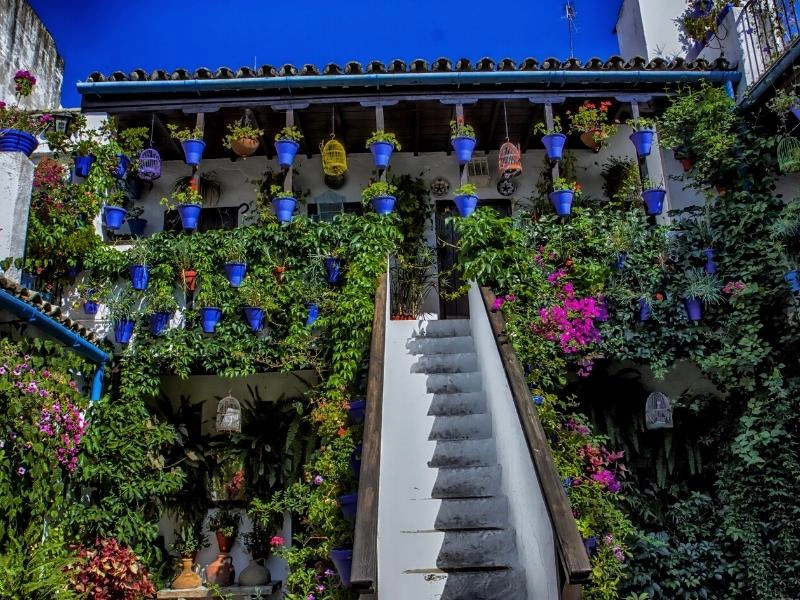
Spot the Triumphal Statues
These are numerous statues of San Rafael around Cordoba. Known as ‘the triumphs’, these statues were a fervent expression of religious devotion. In years of great suffering or plagues, the people of Cordoba expressed their veneration of the Archangel San Rafael by building these triumphal statues all over the city.
Near the Puerta del Puente, or Gateway to the Bridge, is the most elaborate and important statue of San Rafael. It was built in the 17th century by Miguel de Verdiguer. The ethereal column which supports the Archangel’s statue stands atop a tower which rises out of a grotto, symbolising three worlds: the underworld, the earth and heaven.
On the Roman Bridge is the oldest statue. Created by local sculptor Bernabé Gómez del Río, it dates back to 1651, and was incorporated into a parapet on the Roman Bridge to bless all visitors who cross the river.
There are other statues in Plaza de la Compañía, on the Conde de Guadalhorce Roundabout, in the Plaza de los Aguayos, on Calle Sebastián Cuevas, and in Plaza de San Hipólito, Puerta Nueva, Plaza de San Basilio and Plaza del Potro
The numerous triumphal statues of San Rafael, the city’s patron and protector, look down for eternity in and keep a protective eye on the city and all who live in it.
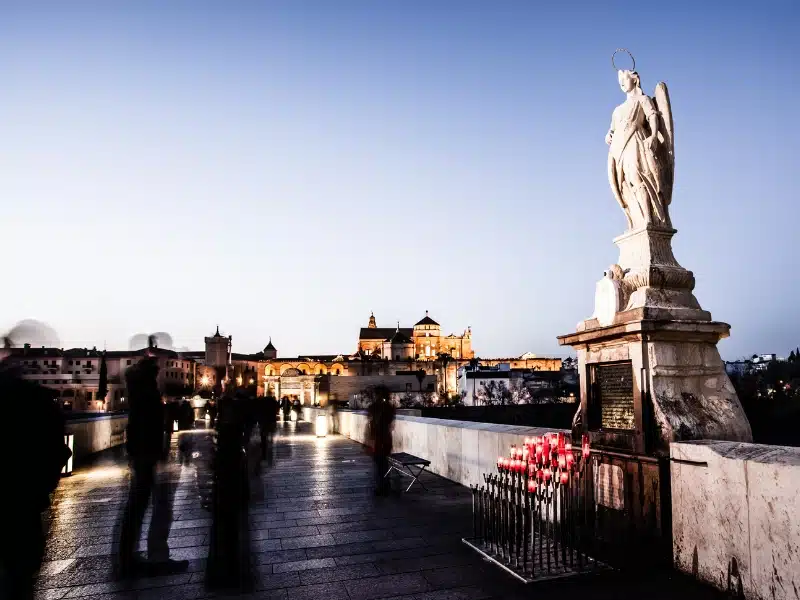
Visit the Ancient Templo Romano
From the San Basilio quarter, take a ten minute walk north through the Juderia (Jewish Quarter), passing many historical buildings, to Plaza de Santa Victoria, home to the Cordoba Archaeological Museum.
From here, head to the impressive Roman Temple which was discovered in the 1950s. Its eight imposing columns stand alone against the blue skies marking the Roman period in Cordoba’s history.
From there, the 17th century Plaza de la Corredera makes a charming place to stop and enjoy the lively atmosphere, perfect for sitting and enjoying a late afternoon beer or glass of cool and crisp Cava, Spain’s delicious sparkling wine.
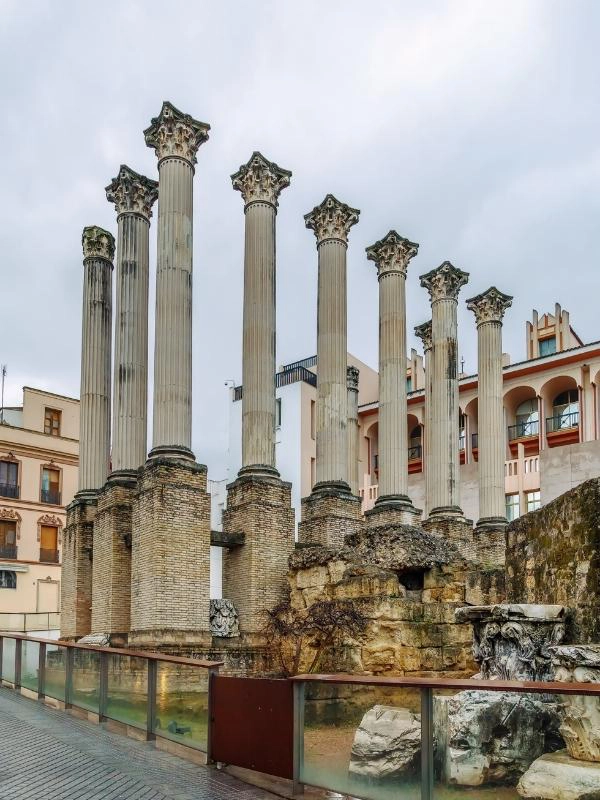
Evening
Cross the Puente Romano
The Puente Romano is the city’s famous Roman Bridge, which dates from the 1st century BC and was extensively rebuilt in the 10th century during the Moorish occupation of the city.
This low and distinctive bridge crosses the wide Guadalquivir River, which heads south through Andalucia before reaching the Atlantic Ocean. Seventeen stone arches support the bridge, only two are left from the original structure – see if you can spot them.
This is a beautiful bridge to walk across, passing the famous Torre de la Calahorra, which is also a museum, before crossing and heading into the old town and Jewish Quarter. In the early evening, as the sun sets behind the city, the light is perfect for capturing those iconic images of the bridge and Mezquita in harmony.
TOP TIP: Linger past sunset for the sky to turn a magical shade of deep blue and the honey-colored Mezquita and bridge to be dramatically lit for the night.
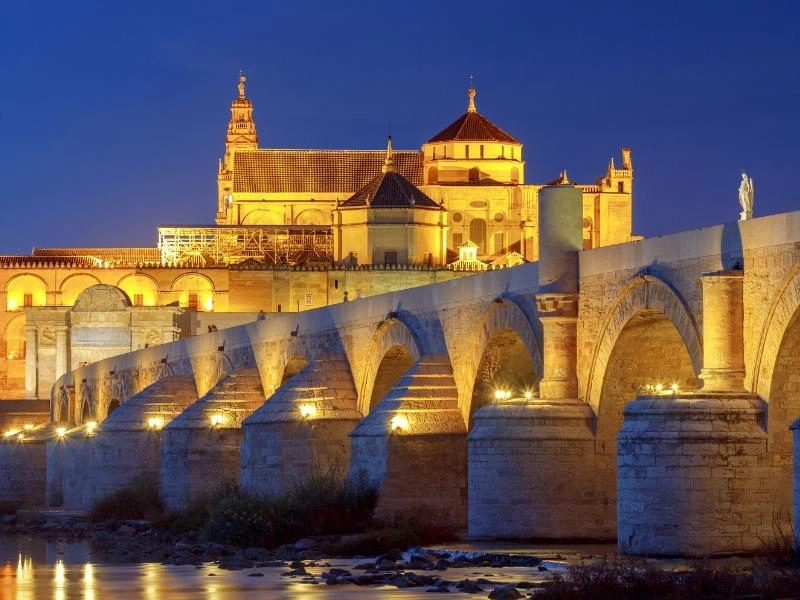
Admire the Calahorra Tower
The 13th century Torre de la Calahorra is a fortress of Islamic origin that provides the entrance and protection of the Roman Bridge of Córdoba. As well as being a fortress, the tower has also been a prison for nobles, a women’s educational center, and a barracks for the Civil Guard. Today, the tower houses the headquarters of the Living Museum of al-Ándalus.
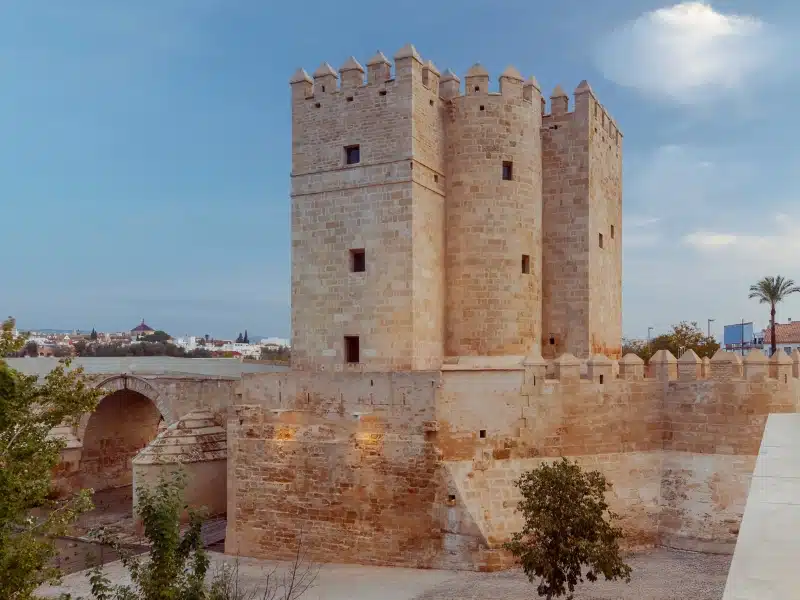
Explore Tapas!
Tapas is a way of life in Spain. Go to any bar or restaurant and you’ll find traditional Spanish food served as a tapa (snack) or a racione (small plate).
Tapas is loosely used to describe both those dishes, as well as pintxos (food on a stick) which come from the north of Spain, and montadito (food on bread). Sound good?
True tapas is served and eaten as a snack with a beer or other alcoholic drink, sometimes this comes free with your drink. If not, expect to pay around €4 for each tapa when you’re in a city like Cordoba.
Raciones are larger plates, usually a half-portion, and tend to be the size used to serve jamon (ham) or cheese, so perfect for sharing.
Raciones will cost a little more, especially if you order Jamon Iberico, usually the most expensive item on any tapas menu. Jamon Iberico is a prized ham from the leg of the Black Iberian pig and has a strong meaty, cured flavor.
If you’re a tapas newbie, taking a tapas tour is the perfect way to learn the ins and outs of this very Spanish tradition. Plus, you’ll also get to try tapas in the best places in town.
TOP TIP: If you find the strong flavor of Jamon Iberico too much, then try Jamon Serrano, a less intense and lighter flavor, and not quite so punishing on the pocket either.
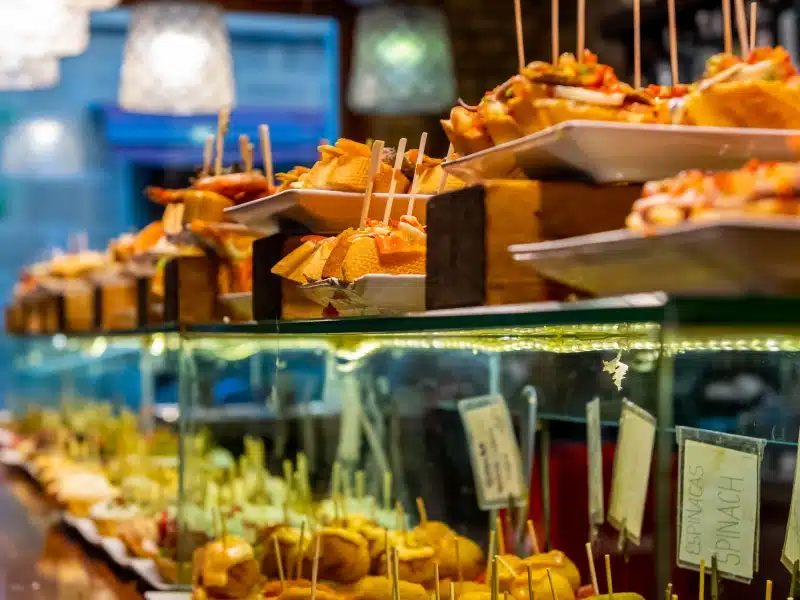
See a Flamenco Show
The national dance of Spain, flamenco is really more theatre than dance. The passion, rhythm, and story at a live flamenco show will get your feet tapping and your heart beating, especially if you take in a show at a historic location like the 10th century Arabian Baths of Santa Maria.
There is even a word for it – ‘duende’ – which does not have a direct translation but refers to how the performance affects those watching.
We recommend this top-rated flamenco show with drinks, performed by seven award-winning artists at Tablao Flamenco El Cardenal in the heart of Córdoba.
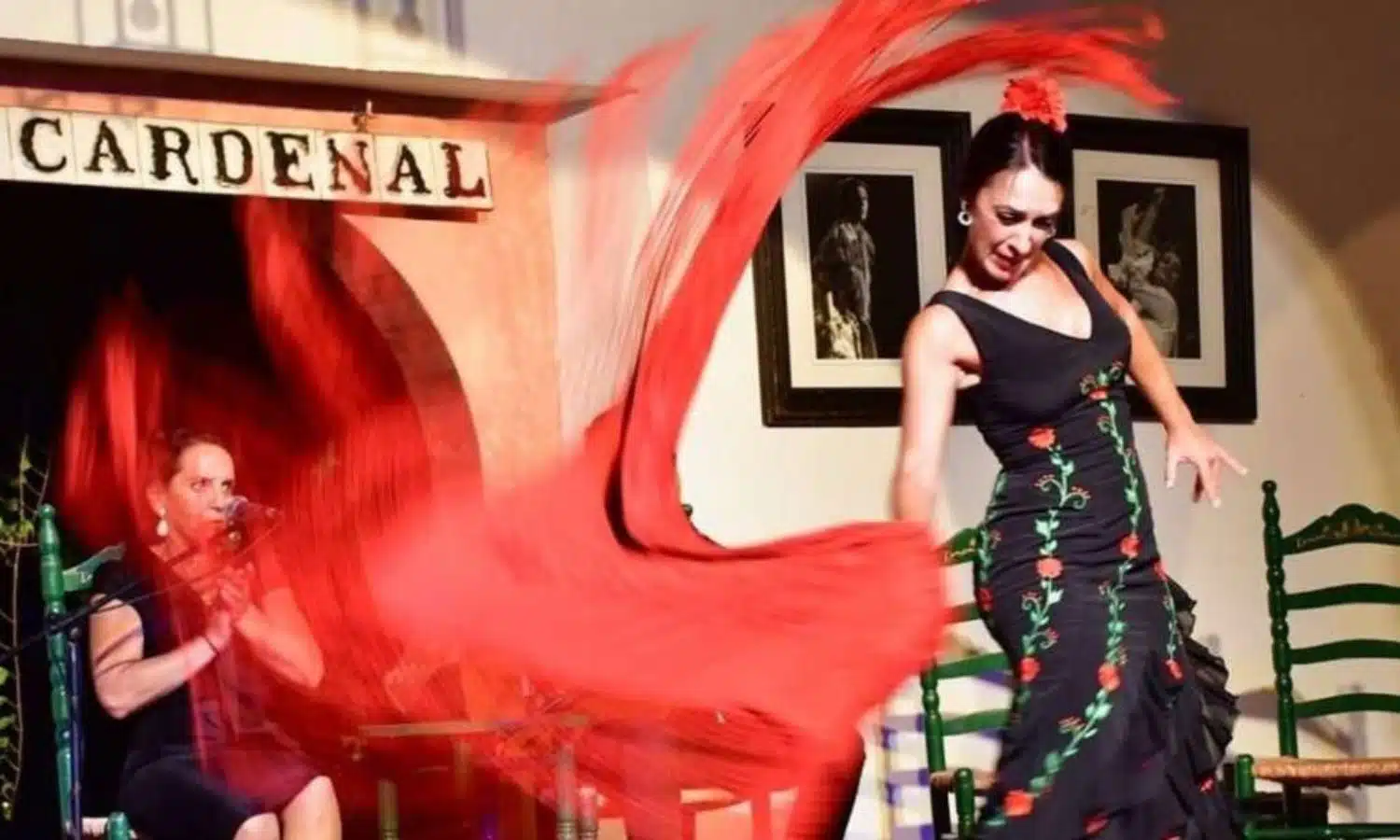
Take a Cordoba Night Visit
Experience Cordoba after dark with the El Alma de Córdoba or Soul of Cordoba night visit at the Mezquita, which offers a small number of visitors the chance to explore one of the world’s most unique religious structures under illumination with an audio guide.
As darkness envelops the Mezquita, your journey begins with a captivating ten minute documentary in one of the galleries of the Patio de los Naranjos, delving into the rich history of the Mosque of Cordoba.
Inside, the vast space initially cloaked in darkness gradually reveals its intricate details as you explore the designated route, guiding you through the building’s remarkable sections.
TOP TIP: The night visit is a lovely way to spend an hour if you have plenty of time to spare in the evening, but we don’t recommend making this your main visit to the Mezquita, which you really need to see for the first time in daylight.
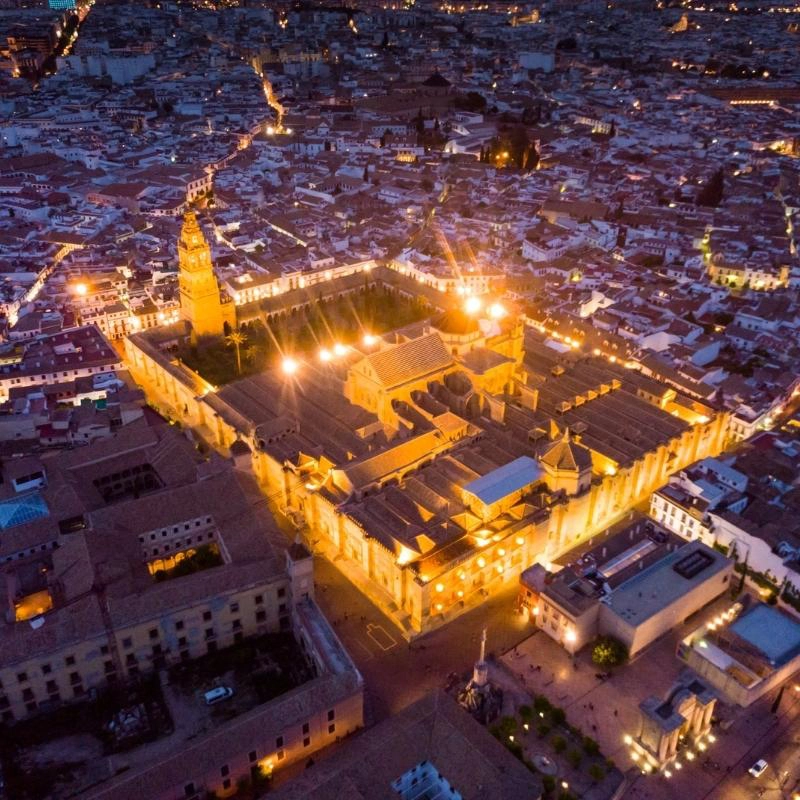
Where to Eat in Cordoba
Mercado Victoria
Head to the gourmet food market of Mercado Victoria for lunch. This gentrified food court, where you’ll find kiosks showcasing and serving great local Spanish food, is lively and fun, and a great spot for food at any time of the day.
One of the top things to try is the flamenquin (little flamenco dancer), a deep-fried roll of breaded pork fillet, filled with Gruyere cheese, Jamon Serrano, lemon juice, and olive oil – you won’t regret it!
Bodegas Mezquita
Bodegas Mezquita serves delicious tapas and regular menu choices, offering traditional Spanish food. The wine list is reasonably priced, try the silky smooth local montilla with dessert, a type of sticky and sweet sherry (but it’s not called sherry because it’s not made in the revered ‘sherry triangle’).
Go after 9pm if you want atmosphere and conviviality. This is the absolute earliest that Andalucian Spain will deign to eat, and Cordoba is renowned for its late restaurant hours. Don’t be surprised if families are still arriving for dinner at 11pm.
We ate at the Corregidor restaurant, but they have three others in Cordoba: Cespedes, Cruz del Rastro, and Ribera.
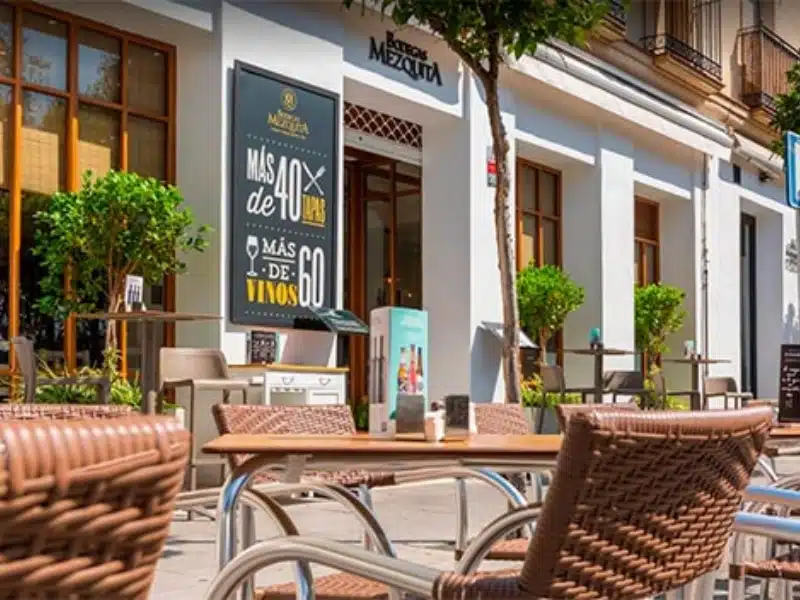
Top Five Cordoba Travel Tips
- The best place to hang out where the locals do is Paseo de la Ribera, or just La Ribera. This perfect spot is where you’ll find the most authentic taberna Cordobesa.
- The Mezquita remains a Catholic place of worship and you won’t be able to enter if your shoulders are bare or you’re wearing shorts. Make sure to cover up or take a shawl or wrap.
- One of the best things to do before leaving home is to book your Mezquita tickets, ideally before 11am or after 3pm. This gives you the best opportunity to enjoy the architectural masterpiece without hordes of other people around.
- Head for Calleja de las Flores in the Juderia. The most Instagrammable spot in Cordoba, this street of flowers with every house displaying colorful and lush pots and hanging baskets, is a truly gorgeous sight.
- Don’t forget to look up! As you walk along the alleys and squares of the city, look up to fully appreciate the beauty of the architecture, the colors of the ubiquitous window boxes, and the traditional materials that are still present in many buildings.
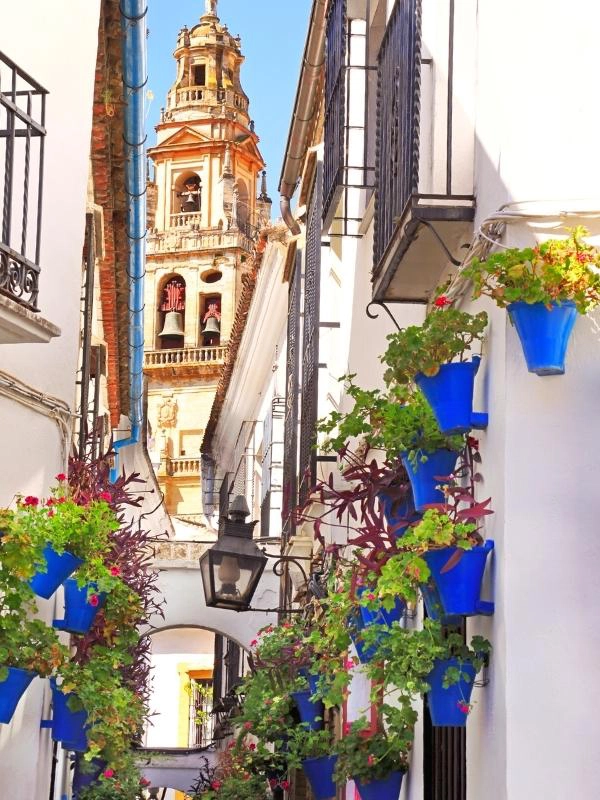
More Than One Day in Cordoba?
If you have extra time to spend in Cordoba, add these attractions to your itinerary:
Medina Azahara
If you have another day or half a day in Cordoba, take a taxi or organized guided tour out to Madinat al-Zahra, or Medina Azahara, known as the radiant city.
This fascinating archaeological site was a fortified palace-city on the western outskirts of Córdoba. The city was built in the 10th century by Abd ar-Rahman III, the first caliph of Al-Andalus. It served as the capital of the Caliphate of Córdoba and its center of government.
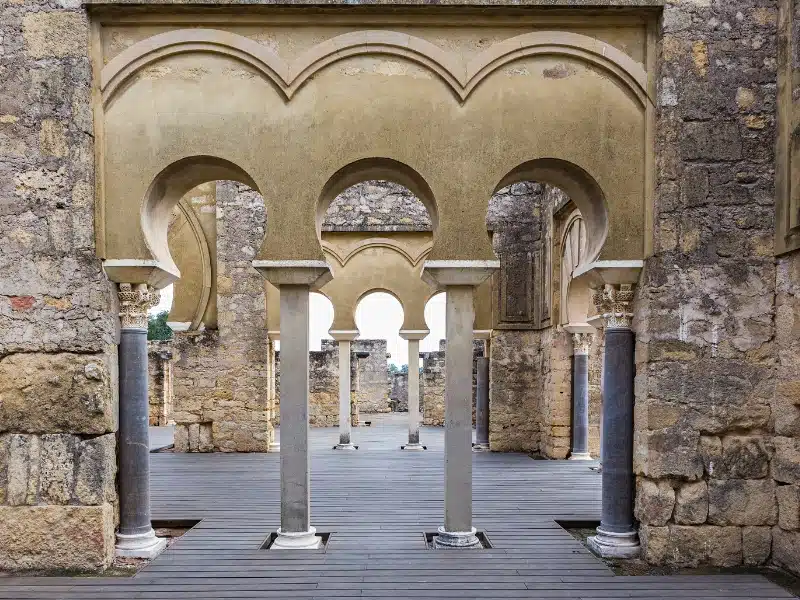
Caballerizas Reales
If you have enough time, visit the Caballerizas Reales, The Royal Stables of Córdoba, which were founded by Philip II in the 16th century. It was here that the first Andalusian horse was first bred from Arab stock.
Today, the Royal Stables are a site of a permanent equestrian display with a variety of shows which include both horses and flamenco!
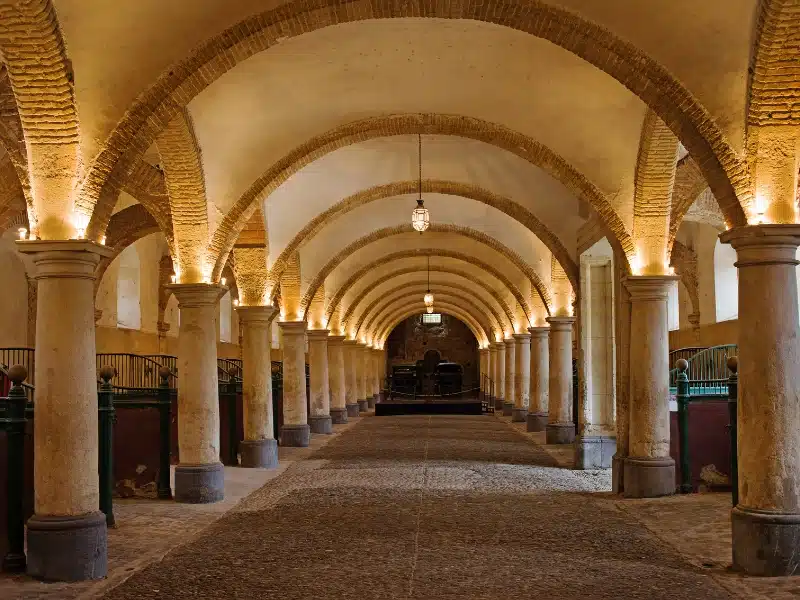
When to Visit Cordoba
You can travel to Cordoba at any time of the year. In winter, Cordoba will be mild and it’s unlikely to rain, although the evenings will be chilly.
Locals tend to wrap up in coats and boots during the winter months but a long-sleeved top and trainers are enough on all but the worst days, of which there are few.
Avoid summer if at all possible. You’ll find yourself missing things in your quest for shade!
Southern Spain is very, very hot in the peak summer months and Cordoba is even hotter, because of its location in an area known as ‘the frying pan of Europe’. It will also be rammed with day-tripping tourists from the coast.
Spring and autumn are the best times to visit. There will be fewer tourists and you’re are likely to get better deals on accommodation. But the main reason to visit in the shoulder seasons of spring or fall is to avoid the heat of the summer and enjoy perfect sightseeing weather.
RELATED POST: Wintering in Spain: Best Winter Destinations in Spain
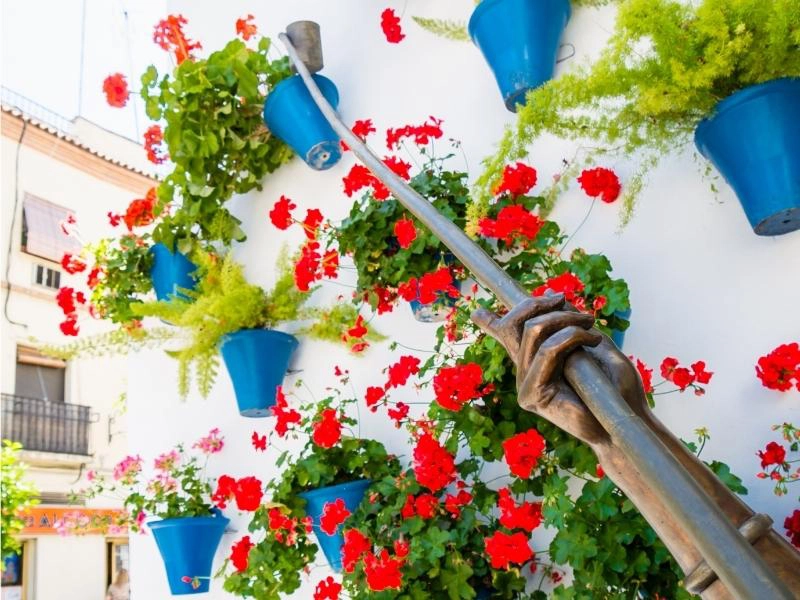
Cordoba Practicalities
Getting to Cordoba
Flying
If you are flying to Córdoba, you can choose to fly to any one of four airports: Seville San Pablo Airport is the closest and best option, followed closely by Malaga Costa Del Sol Airport, then Federico García Lorca Granada-Jaén Airport and finally Jerez Airport, if you are already in Spain.
You can hire a car at all of these airports and drive through the gorgeous Spanish countryside to Cordoba, probably the quickest and easiest way to get to your destination.
From Seville Airport you will first need to get a bus to Santa Justa bus station in Seville city centre, which runs often and takes about 35 minutes. You can buy your ticket on the bus. From Santa Justa, you can catch a direct Renfe train to Cordoba Central train station, which runs frequently and takes around 45 minutes.
From Malaga Airport you will need to take the train from the airport to Estación de Málaga-María Zambrano. The trains run every 20 minutes and take 8 minutes. Once there you can catch a direct train to Cordoba which runs frequently and takes around an hour.
From Granada Airport you will need to take a bus from the airport into Granada. Buses run approximately 30 minutes after every flight arrival from outside the arrivals hall and take 60 minutes. You can buy your ticket on the bus. Once at Granada railway station, you can catch a direct Renfe train to Cordoba. Trains run every four hours and take 90 minutes to arrive.
From Jerez Airport you will need to take a train to Jerez de la Frontera railway station. Trains run frequently in the morning until 12.15pm, and then there is one additional train in the early evening. The journey takes 9 minutes. Once at the station, you can catch a direct train to Cordoba. Trains leave every 3 hours or so and the journey time is just under 3 hours.
Book and compare bus and train tickets with Omio, to find the best service and deals.
For a great way to start your Cordoba trip book a private transfer from the airport with Intui directly to your accommodation in the city center – it’s more cost-effective than you think! Intui works with a large range of local operators to bring the best options and prices for your transfer.
Are you visiting Cordoba as part of a longer trip? A Spanish road trip is the best way see this gorgeous country, and our guide to road tripping in Spain has all you need, including maps, routes, highlights and tips, to help you plan the perfect trip.
Where to Stay in Cordoba
Luxury: Balcón de Córdoba – Booking.com | Agoda
Our favorite place to stay in Cordoba, Balcon de Cordoba is a small and intimate boutique hotel with glorious views over the city from its roof terrace. Perfectly located, with gorgeous outdoor patios for dining and relaxing and rooms decorated in traditional Spanish style, it’s no surprise this hotel is a popular choice.
Mid-Range: Las Casas de la Juderia – Booking.com | Agoda
Located in central Córdoba, just a few hundred meters from the Mezquita, Las Casas de la Judería offers a charming stay amidst a collection of historic mansions and courtyards. The rooms blend old-world charm with modern amenities, and there’s a lovely pool on-site, perfect for a late afternoon dip after a busy day.
Budget: La Boutique Puerta Osario – Booking.com | Agoda
Located on Calle Osario, which would have led through the (destroyed) Osario Gate into the old town, La Boutique Puerta Osario offers modern and comfortable rooms in a good location.
Hostel: Líbere Córdoba Patio Santa Marta – Booking.com | Agoda
One of the best hostels in Cordoba, Líbere Córdoba Patio Santa Marta is known for its great location, swimming pool, and clean and airy rooms. Offering a wide choice of dorms, rooms, and family rooms, this is a great place to stay if you’re visiting Coedoba on a budget.
Make sure you have travel insurance you can trust when visiting Spain. We recommend True Traveller for their 5-star TrustPilot reviews, variety of cover options, best activities cover as standard, great prices, and excellent service.
Are you looking for more one day city guides? Check out these top posts…
Prague One Day Itinerary + Map, Tips & Guide
Amsterdam One Day Itinerary + Map, Tips & Guide
Belfast in A Day: Itinerary, Map & Tips
One Day Munich Itinerary + Map, Tips & Guide
Stockholm One Day Itinerary + Map, Tips & Guide
One Day in Venice – Itinerary, Map, Tips & Guide
Love it? Pin it!
